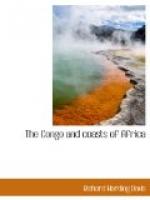The morning after we sailed from Duala we anchored in the river in front of Calabar, the capital of Southern Nigeria. Of all the ports at which we touched on the Coast, Calabar was the hottest, the best looking, and the best administered. It is a model colony, but to bring it to the state it now enjoys has cost sums of money entirely out of proportion to those the colony has earned. The money has been spent in cutting down the jungle, filling in swamps that breed mosquitoes and fever, and in laying out gravel walks, water mains, and open cement gutters, and in erecting model hospitals, barracks, and administrative offices. Even grass has been made to grow, and the high bluff upon which are situated the homes of the white officials and Government House has been trimmed and cultivated and tamed until it looks like an English park. It is a complete imitation, even to golf links and tennis courts. But the fight that has been made against the jungle has not stopped with golf links. In 1896 the death rate was ten men out of every hundred. That corresponds to what in warfare is a decimating fire, upon which an officer, without danger of reproof, may withdraw his men. But at Calabar the English doctors did not withdraw, and now the death rate is as low as three out of every hundred. That Calabar, or any part of the West Coast, will ever be made entirely healthy is doubtful. Man can cut down a forest and fill in a swamp, but he can not reach up, as to a gas jet, and turn off the sun. And at Calabar, even at night when the sun has turned itself off, the humidity and the heat leave one sweating, tossing, and gasping for air. In Calabar the first thing a white man learns is not to take any liberties with the sun. When he dresses, eats, drinks, and moves about the sun is as constantly on his mind, as it is on the face of the sun-dial. The chief ascent to the top of the bluff where the white people live is up a steep cement walk about eighty yards long. At the foot of this a white man will be met by four hammock-bearers, and you will see him get into the hammock and be carried in it the eighty yards.
For even that short distance he is taking no chances. But while he nurses his vitality and cares for his health he does not use the sun as an excuse for laziness or for slipshod work. I have never seen a place in the tropics where, in spite of the handicap of damp, fierce heat, the officers and civil officials are so keenly and constantly employed, where the bright work was so bright, and the whitewash so white.
Out at the barracks of the West African Frontier Force, the W.A.F.F.’s, the officers, instead of from the shade of the veranda watching the non-coms. teach a native the manual, were themselves at work, and each was howling orders at the black recruits and smashing a gun against his hip and shoulder as smartly as a drill sergeant. I found the standard maintained at Calabar the more interesting because the men were




